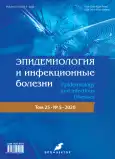Этиология острых кишечных инфекций вирусной природы в Алтайском крае
- Авторы: Никонорова М.А.1, Карбышева Н.В.1, Шевцова Е.А.1, Бесхлебова О.В.1
-
Учреждения:
- Алтайский государственный медицинский университет
- Выпуск: Том 25, № 5 (2020)
- Страницы: 200-209
- Раздел: ОРИГИНАЛЬНЫЕ ИССЛЕДОВАНИЯ
- URL: https://journals.rcsi.science/1560-9529/article/view/58736
- DOI: https://doi.org/10.17816/EID58736
- ID: 58736
Цитировать
Полный текст
Аннотация
Обоснование. Заболеваемость острыми кишечными инфекциями (ОКИ) повсеместно сохраняется на высоком уровне. Значительный прогресс, достигнутый в области лабораторной диагностики, позволил перейти к подробному изучению этиологической структуры ОКИ, и в результате было установлено, что в последние годы заметно возросла роль возбудителей вирусной природы, однако детальное изучение характеристик этих инфекций требует дальнейших исследований.
Цель исследования ― изучение структуры и клинико-лабораторных особенностей кишечных инфекций вирусной этиологии у взрослых госпитализированных пациентов в Алтайском крае.
Материал и методы. С 2017 по 2020 г. проведено одномоментное исследование 67 пациентов с ОКИ вирусной этиологии в возрасте от 18 до 76 лет, госпитализированных в инфекционные отделения КГБУЗ «Городская больница № 5, г. Барнаул». С целью определения структуры ОКИ использовали метод полимеразной цепной реакции (ПЦР) с гибридизационно-флюоресцентной детекцией «АмплиСенс® ОКИ скрин-FL»; бактериологический и серологический (реакция непрямой гемагглютинации) методы. С учётом результатов лабораторного обследования (молекулярно-генетического, бактериологического и серологического) все пациенты были разделены на 3 группы: 1-я (n=45; 67,2%) ― пациенты с вирусной моноинфекцией, 2-я (n=9; 13,4%) ― с вирусной микст-инфекцией, 3-я (n=13; 19,4%) ― с сочетанной вирусно-бактериальной этиологией. Обработку и графическое представление данных проводили с помощью компьютерных программ Statistica 10.0 (русифицированная версия), Excel 2010 (Windows 10).
Результаты. Среди ОКИ вирусной этиологии моновирусные формы установлены в 67,2% случаев, смешанные ― в 32,8%, из них микст-вирусной этиологии ― 13,4%, вирусно-бактериальной ― 19,4%. Среди моновирусных ОКИ доминировала норовирусная инфекция (52,9%). Не выявлено различий в клинико-лабораторных показателях моно- и поливирусной инфекции, как и в группах моновирусных инфекций (ротавирусной, аденовирусной и норовирусной), что согласуется с ранее полученными данными. Так же с лихорадочным синдромом, водянистой диареей и болевым абдоминальным синдромом протекала коинфекция сальмонеллёза в сочетании с одним и/или несколькими вирусами.
Заключение. Таким образом, у взрослых пациентов в условиях инфекционного стационара в структуре вирусных ОКИ методом ПЦР установлена моно- и микст-вирусная инфекция (в сочетании с двумя и более вирусами либо бактериями). Статистически значимого различия клинико-лабораторных показателей в группах исследования не установлено ввиду недостаточного размера выборки. Целесообразны дальнейшие исследования по аналогичному протоколу с участием большего числа пациентов.
Полный текст
Открыть статью на сайте журналаОб авторах
Марина Анатольевна Никонорова
Алтайский государственный медицинский университет
Email: ma.nikulina@mail.ru
ORCID iD: 0000-0001-6621-9310
доктор медицинских наук, доцент, профессор кафедры инфекционных болезней и фтизиатрии
Россия, 656038, Алтайский край, Барнаул, пр-т Ленина, д. 40Нина Валентиновна Карбышева
Алтайский государственный медицинский университет
Email: nvk80@rambler.ru
ORCID iD: 0000-0001-8320-3468
SPIN-код: 7917-7849
доктор медицинских наук , профессор, зав. кафедры инфекционных болезней и фтизиатрии
Россия, 656038, Алтайский край, Барнаул, пр-т Ленина, д. 40Екатерина Андреевна Шевцова
Алтайский государственный медицинский университет
Email: katyapes@mail.ru
ORCID iD: 0000-0001-8342-3110
аспирант
Россия, 656038, Алтайский край, Барнаул, пр-т Ленина, д. 40Ольга Васильевна Бесхлебова
Алтайский государственный медицинский университет
Автор, ответственный за переписку.
Email: olg.deriglazova@yandex.ru
ORCID iD: 0000-0003-4561-1019
SPIN-код: 5033-5574
кандидат медицинских наук
Россия, 656038, Алтайский край, Барнаул, пр-т Ленина, д. 40Список литературы
- О состоянии санитарно-эпидемиологического благополучия населения в Российской Федерации в 2019 году: Государственный доклад. Москва : Федеральная служба по надзору в сфере защиты прав потребителей и благополучия человека, 2020. 299 с.
- Усенко Д.В., Горелова Е.А. Острые кишечные инфекции вирусной этиологии у детей: возможности диагностики и терапии // Медицинский совет. 2017. № 9. С. 86–92. doi: 10.21518/2079-701X-2017-9-86-92
- Боброва Н.К., Воробьева О.А. Современные клинико-эпидемиологические особенности течения ротавирусной инфекции у взрослых // Забайкальский медицинский вестник. 2020. № 1. С. 7–11.
- Молочный В.П., Копачевская К.А., Заварцева Л.И. и др. О рациональности существующей практики эмпирической антибактериальной терапии детей раннего возраста, больных острыми кишечными инфекциями // Дальневосточный медицинский журнал. 2017. № 1. С. 47–51.
- Сергевнин В.И., Кузовникова Е.Ж., Трясолобова М.А. Внутригодовая динамика эпидемического процесса острых кишечных инфекций и причины, обусловливающие ее характер // Медицинский алфавит. 2017. Т. 2, № 18. С. 32–33.
- Грижевская А.Н., Островская О.С., Ляховская Н.В., Хныков А.М. Структура госпитализированных с острыми кишечными инфекциями в 2015–2016 гг. // Достижения фундаментальной, клинической медицины и фармации: материалы 72-й научной сессии сотрудников университета. Витебск, 2017. С. 76–78.
- Антипов М.О., Миндлина А.Я. Эпидемиологическая характеристика наиболее актуальных болезней органов пищеварения инфекционной природы в регионах России // Профилактическая медицина. 2020. № 3. С. 76–80. doi: 10.17116/profmed20202303176
- Долгов В.В. Клиническая лабораторная диагностика. В 2 т. Т. 1. Национальное руководство. Москва : ГЭОТАР-Медиа, 2013. 928 с. (Серия «Национальные руководства»).
- Ющук Н.Д. Инфекционные болезни. Национальное руководство. Краткое издание / под ред. Н.Д. Ющука, Ю.Я. Венгерова. Москва : ГЭОТАР-Медиа, 2020. 848 с.
- Никонорова М.А., Салдан И.П., Карбышева Н.В., и др. Острые кишечные инфекции в амбулаторной практике // Эпидемиология и инфекционные болезни. 2018. Т. 23, № 2. С. 85–88. doi: 10.18821/1560-9529-2018-23-2-85-88
- Капустин Д.В., Жираковская Е.В., Соколов С.Н., и др. Вирусные диареи в структуре острых кишечных инфекций у взрослых жителей Новосибирска // Медицина и образование в Сибири. 2016. № 5. С. 9.
- Привалова М.А., Силаева В.В., Пузырёва Л.В., Бардина Н.В. Острые кишечные инфекции в Омской области в 2013–2015 годах // Сибирский медицинский вестник. 2017. № 2. С. 24–30.
- Pawlowski S.W., Warren C.A., Guerrant R. Diagnosis and treatment of acute or persistent diarrhea // Gastroenterology. 2009. Vol. 136, N 6. Р. 1874–1886. doi: 10.1053/j.gastro.2009.02.072
- De Lusignan S., Shinneman S., Yonova I., et al. An ontology to improve transparency in case definition and increase case finding of infectious intestinal disease: database study in english general practice // JMIR Med Inform. 2017. Vol. 5, N 3. Р. e34. doi: 10.2196/medinform.7641
- Лобзин Ю.В., Рычкова С.В., Скрипченко Н.В., и др. Состояние инфекционной заболеваемости у детей в Российской Федерации за 2016–2017 гг. // Медицина экстремальных ситуаций. 2018. Т. 20, № 3. С. 253–261.
- Яковлев А.А., Иванова Э.Н., Котлярова С.И., и др. Моно- и коинфицированные с вирусами формы сальмонеллеза у взрослых // Журнал инфектологии. 2013. Т. 5, № 3. С. 13–18. doi: 10.22625/2072-6732-2013-5-3-13-18
- Любезнова О.Н., Утенкова Е.О. Ротавирусная и норовирусная инфекции у взрослых // Медицинский вестник Северного Кавказа. 2017. № 1. С. 32–35.
Дополнительные файлы






